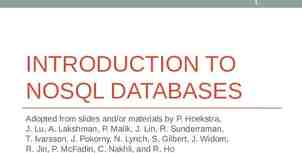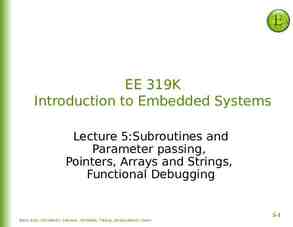Multiprocessor and Real-Time Scheduling Bina Ramamurthy Chapter
29 Slides94.50 KB

Multiprocessor and Real-Time Scheduling Bina Ramamurthy Chapter 10 CSE421 B.Ramamurthy 1

Introduction When a computer system contains more than a single processor, several new issues are introduced into the design of scheduling functions. We will examine these issues and the details of scheduling algorithms for tightly coupled multi-processor systems. B.Ramamurthy 2

Topics for discussion Granularity of computation Design issues Assignment of processes to processors Multiprogramming on individual processors Actual dispatching of a process Real-time systems Characteristics Real-time scheduling Rate-monotonic scheduling (RMS) B.Ramamurthy 3

Granularity The main purpose of having multiple processors is to realize ? Applications exhibit parallelism at various levels. There are at least five categories of parallelism that differ in the degree of granularity. Fine grain parallelism: Parallelism inherent in a single inst. stream. usually does not involve the OS but done at compilation stage. High data dependency high frequency of synch. reqd. B.Ramamurthy 4

Granularity Medium grain: Potential parallelism of an application can be implemented by multiple threads in a single process. High degree of coordination among the threads. Usually programmer specifies the parallelism in the design. Coarse grain: Multiprocessing of concurrent processes in a multiprogramming environment :Example : Prj2. Very coarse grain: When the synchronization needed is not so frequent the processes can be distributed among network nodes to form a single computing environment. Example: CORBA standard for distributed system Independent parallelism: Multiple unrelated processes. B.Ramamurthy 5

Design Issues Assignment of processes to processors. Use of multiprogramming on individual processors. Actual dispatching of a process. B.Ramamurthy 6

Process/processor Assignment Master/slave assignment: Kernel functions always run on a particular processor. Other processors execute user processes. Advantage: Resource conflict resolution simplified since single processor has control. Problem: Failure of master processor? Master processor does the scheduling bottleneck. Peer assignment: OS can execute on any processor. Each processor does its own scheduling from the pool of available processes. This is similar to Solaris or NT symmetric multiprocessing (SMP). B.Ramamurthy 7

Multiprogramming at each processor Completion time and other applicationrelated performance metrics are much more important than processor utilization in multi-processor environment. For example, a multi-threaded application may require all its threads be assigned to different processors for good performance. Static or dynamic allocation of processes. B.Ramamurthy 8

Process dispatching After assignment, deciding who is selected from among the pool of waiting processes --- process dispatching. Single processor multiprogramming strategies may be counter-productive here. Priorities and process history may not be sufficient. B.Ramamurthy 9

Process scheduling Single queue of processes or if multiple priority is used, multiple priority queues, all feeding into a common pool of processors. Multi-server queuing model: multiple-queue/single queue , multiple server system. Study the system for 1, 2, and n processors. Inference: Specific scheduling policy does not have much effect as the processor number increases. Conclusion: Use FCFS with priority levels. B.Ramamurthy 10

Thread scheduling An application can be implemented as a set of threads that cooperate and execute concurrently in the same address space. Criteria: When related threads run in parallel perf. improves. Load sharing: pool of threads, pool of processors. Gang scheduling: Bunch of related threads scheduled together. Dedicated processor assignment: Each program gets as many processors as there are parallel threads. Dynamic scheduling: More like demand scheduling. B.Ramamurthy 11

Real-time systems Real-time computing is an important emerging discipline in CS and CE. Control of lab experiments, robotics, process control, telecommunication etc. It is a type of computing where correctness of the computation depends not only on the logical results but also on the time at which the results are produced. Hard real-time systems: Must meet deadline. Ex: Space shuttle rendezvous with other space station. Soft real-time system: Deadlines are there but not mandatory. Results are discarded if the deadline is not met. B.Ramamurthy 12

Characteristics of Real-Time (RT) systems Determinism Responsiveness User control Reliability Fail-soft operation B.Ramamurthy 13

Deterministic Response External event and timings dictate the request of service. OS’s response depends on the speed at which it can respond to interrupts and on whether the system has sufficient capacity to handle requests. Determinism is concerned with how long the OS delays before acknowledging an interrupt. In non-RT this delay may be in the order of 10’s and 100’s of millisecs, whereas in an RT it may have an upper-bound of few microsec to 1millisec. B.Ramamurthy 14

RT . Responsiveness Responsiveness is the time for servicing the interrupt once it has been acknowledged. Comprises: Time to transfer control, (and context switch) and execute the ISR Time to handle nested interrupts, the interrupts that should be serviced when executing this ISR. Higher priority Interrupts. response time F(responsiveness, determinism) B.Ramamurthy 15

RT . User Control User control : User has a much broader control in RT-OS than in regular OS. Priority Hard or soft deadlines Deadlines Memory Managemenmt: paging or swapping Name the processes to be resident in memory Scheduling policies B.Ramamurthy 16

RT . Reliability Reliability: A processor failure in a non-RT may result in reduced level of service. But in an RT it may be catastrophic : life and death, financial loss, equipment damage. Fail-soft operation: Ability of the system to fail in such a way preserve as much capability and data as possible. In the event of a failure, immediate detection and correction is important. Notify user processes to rollback. Apply compensation. B.Ramamurthy 17

Requirements of RT Fast context switch Minimal functionality (small size) Ability to respond to interrupts quickly (Special interrupts handlers) Multitasking with signals and alarms Special storage to accumulate data fast Preemptive scheduling B.Ramamurthy 18

Requirements of RT (contd.) Priority levels Minimizing interrupt disables Short-term scheduler (“omni-potent”) Time monitor Goal: Complete all hard real-time tasks by dead-line. Complete as many soft real-time tasks as possible by their deadline. B.Ramamurthy 19

Preemption and short-term scheduling Fig.10.4 B.Ramamurthy 20

RT scheduling Static table-driven approach For periodic tasks. Input for analysis consists of : periodic arrival time, execution time, ending time, priorities. Inflexible to dynamic changes. General policy: earliest deadline first. B.Ramamurthy 21

RT scheduling Static priority-driven preemptive scheduling For use with non-RT systems: Priority based preemptive scheduling. Priority assignment based on real-time constraints. Example: Rate monotonic algorithm B.Ramamurthy 22

RT scheduling Dynamic planning-based scheduling After the task arrives before execution begins, a schedule is prepared that includes the new as well as the existing tasks. If the new one can go without affecting the existing schedules than nothing is revised. Else schedules are revised to accommodate the new task. Remember that sometimes new tasks may be rejected if deadlines cannot be met. B.Ramamurthy 23

RT scheduling Dynamic best-effort scheduling: used in most commercial RTs of today tasks are aperiodic, no static scheduling is possible some short-term scheduling such as shortest deadline first is used. Until the task completes we do not know whether it has met the deadline. B.Ramamurthy 24

Deadline scheduling Characteristics considered Aperiodic tasks Ready time Starting deadline Completion deadline Processing time Resource requirements Priority B.Ramamurthy 25

Scheduling tasks with completion deadline Fig. 10.5, Table 10.2 B.Ramamurthy 26

Scheduling tasks with starting deadline Fig. 10.6, Table 10.3 B.Ramamurthy 27

Rate Monotonic Scheduling Fig. 10.7, Fig. 10.8, Table 10.4 B.Ramamurthy 28

Summary We studied issues and algorithms in Multi-processor scheduling Thread scheduling Real-time scheduling B.Ramamurthy 29






